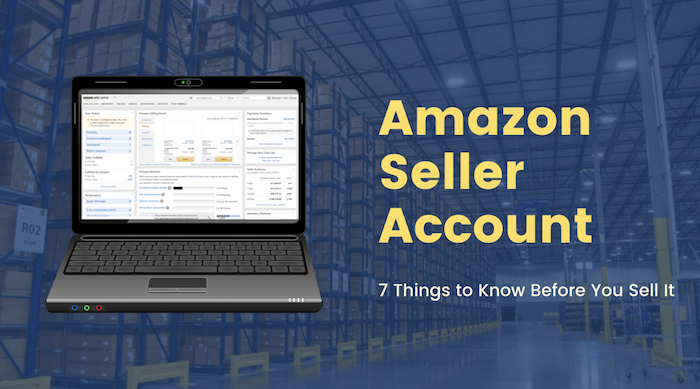The COVID-19 outbreak has rapidly reshaped the world. While the economy is sinking, e-commerce, specifically Amazon, is booming and flourishing.
The share price of Amazon.com Inc has seen a growth of 40% since March (overall, e-commerce has seen sales growth of 78% in May) and Jeff Bezos, its founder and CEO, is rumored to become the first-ever trillionaire within 10 years.
At the same time, third-party Amazon seller sales have been growing at a rate of 50+ percent a year and now account for almost 60% of total Amazon sales.
It is easy to see why so many sellers want to join that train too. But what happens if, for whatever reason, you want to quit and sell your Amazon business account?
Is it even allowed? How would you go about it?
We would like to address the seven most common fears people may have while thinking about quitting e-commerce and selling their Amazon accounts.
Read this article carefully to learn how you can sell your business store smoothly while maximizing profits.
1. Is it Really Possible or Legal to Sell Your Amazon Account?
Photo: designnews.com

In short: yes and yes. According to Amazon policy:
Seller accounts generally are not transferable. (Amazon)
But that’s only “generally.” In practice, any Amazon account can be legally transferred to a new owner with a completely new legal entity, business address, bank account, credit card, phone number, etc.
The full transfer takes around 5-7 days once done professionally. Such a deal is absolutely legal, and you can sign a sales and purchase agreement with the buyer to be fully protected.
Reverification
The only requirement for transferring an account is that the store must not be in dormancy, i.e., hasn’t sold for a long time and has become inactive.
In that case, you, as a current store owner, must do the reverification. Amazon will want you to upload a valid personal ID and a recently issued bank account or credit card statement. The whole process is basically a two-click process and it takes 1-2 hours to get your store reverified and reactivated.
Note: This is the Amazon support only that can see your sensitive data so you can be absolutely patient about it. No third party will ever see them.
After you have uploaded and reverified your account, you can proceed with selling it. The new owner will remove all of your details and add their own business credentials according to the common practice.
2. Who Would Actually Need My Amazon Store? Russian Mafia?
Photo: newsweek.com

Let's be honest. Not everyone is passionate about e-commerce.
Being an Amazon seller, you have to be engaged in many things like market analysis, producing or buying a product that stands out, dealing with complaints, suspensions, product authenticity, and intellectual property issues, negative feedback, refunds, and much more.
Some people want to avoid that headache and look to sell their assets and quit the online marketplace entirely. Let the professional sellers do their job.
The guys who need your account are average US companies that aim to expand their market presence by purchasing an e-commerce store or a working e-commerce business. There are no gangsters.
Selling your Amazon account is a great opportunity for you to quickly quit your venture and get paid for that. Even a fresh-made Amazon seller account is worth a couple hundred dollars.
Note: All you need is to find a trusted all-in-one service that would help you sell your store with ease. Premium Sellers is the service you are looking for.
3. How Does the Amazon Account Transfer Process Work?
Photo: videohive.net

Again, according to the official Amazon policy, Amazon seller accounts GENERALLY are not transferable. That's generally. But in fact, those are absolutely transferable.
And there are two options:
a) You sell your Amazon store along with the company it is attached to.
This is often the most difficult way to sell since besides evaluating your store in general, the buyer must check the company and its financial information, such as debts or taxes owed.
Additionally, should the company own property, transport, or products, that must be included into the contract as well. Therefore, for a safe and sound deal, you must hire a lawyer, which is an additional expense for you.
b) The easiest way to go is just selling your Amazon seller account separately from the business (if the account is registered with your personal details, this is also okay).
The transfer process looks like this:
1. You agree on the price (and sign a contract if needed).
2. The buyer sends you the money (bank transfer or PayPal).
3. The seller (you) changes bank account number (deposit method), credit card (charge method), business information, phone number, email address, etc.
That process usually takes a few days.
Important: If you cannot remove your bank account number from the Amazon account, you have to provide the new owner with your full deposit method number since, in order to verify the new deposit method, Amazon kindly asks users to provide the old one. You have to know this is quite risky.This info isn't relevant any more (Update: August 23, 2024)
4. You provide the access to the store (email, password), as well as help them pass the two-factor authentication – 2FA).
Some sellers create separate email accounts specifically for Amazon so they can transfer the email access over to the buyer as well.
This is a very good and preferable practice since, though rarely, Amazon may revert the login email to the original one causing problems for the new owner to access the account.
Note: Some buyers tell the seller that they will change the details themselves. If waiting for them to do it is uncomfortable to you and/or you are afraid to leave your personal details within the store, you can remove or edit some sensitive data, such as the credit card used as Amazon charge method with the one that you don’t plan to use or, for example, expires soon.
It is worth saying, the new owner does not have the access to the credit card details stored in the e-commerce platform (except the last 4 digits and expiration date) so they cannot compromise your card and secretly pay with it.
This is Amazon only that may charge the card should the new owner fail to remove it (however, you may easily cancel the transaction in most cases).
Pro tip: Deal with a reliable service (click here) only to avoid unwanted concerns like the ones above.
5. Once all details are removed, you are done. Bye, Amazon!
4. Can I Create Another Amazon Account After Selling Mine?
Photo: marketingland.com

Unfortunately, not.
Despite all your personal or business details have been removed, you cannot make a new Amazon store at least within 3 years.
The thing is, Amazon does not remove all the data records that have ever been previously used within the platform instantly. Any IPs, devices, names, addresses, bank accounts, and credit cards that have ever been recorded there remain in the archives and databases for a couple of years.
Should you decide to make a new account and use, for example, the same bank account and card, you risk losing both the fresh-made account and the old one, causing problems to the buyer who has become the new owner (suspension).
Therefore, just let it go. Consider selling your Amazon account if you quit the e-commerce business completely.
Note: The above-mentioned is not the case when you want to register a new store for your family member. But be smart.
Do not use the same device/IP address/physical address (better make a new store from your office), same card, or bank account. Also, you can set up a new company for your family member and make a store under that business name. The same rules are applicable there.
If you need a new seller account, it is better to wait for 3 years or use completely separate and unlinked credentials (credit card, bank account, LLC, addresses).
5. How Can I Avoid a Rip Off?
Photo: preemptive.com

Most people have never sold any accounts in their life.
Therefore, this may cause much anxiety. This is normal. Breathe deeply.
We have good news for you: any Amazon account seller is generally better protected and positioned compared to a buyer.
However, you should consider the following to make sure the transaction goes smoothly for both parties:
1. If you have received an offer by email, do not click any links
Also, some scammers send personalized newsletters imitating Amazon support with the click-to-action links within the email.
Those links lead to malware sites imitating the Amazon web interface and asking you to enter your login, password, and 2FA OTP code. Never log in to your account by clicking the link in the email.
When you do, always check the web address bar for where you are located. You should see the encrypted sellercentral.amazon.com URL only.
2. Use screen-sharing apps such as Zoom, Anydesk, or Teamviewer
Those apps are 100% secure for you and are a great way to know your potential buyer, as well as share the details related to the store.
However, some people are quite frustrated about showing their desktop to who knows who. If this is the case with you, and you are not 100% confident you are able to control what’s going on your desktop properly, don’t use those apps.
Better consider sending screenshots or screen-recording videos (CloudApp is a nice app to use).
3. Get an upfront payment
In general, buyers tend to transfer funds upfront after you have demonstrated the account and agreed on the price.
However, you should send the access only after the funds have been verified by the bank if you have chosen the wire transfer. Also, you can use PayPal.
PayPal is a fast and secure payment option. Just make sure that the funds you receive are not stolen and you can safely withdraw them to your bank account.
Once the buyer is not comfortable sending money upfront, you can consider using an escrow service (such as escrow.com).
4. Replace the charge and deposit methods
Make sure that you or another party change the bank account and credit card details stored within the account.
You don't want Amazon to charge you, and without a new deposit method, all proceeds from new selling activities will go straight to your bank account.
6. What Will Happen to My Buyer Account? I’ve Spent $119 on My Prime Subscription
Photo: chargedretail.com

It's a very important thing. Amazon does not differentiate between you trying to log in to Amazon Seller Central (link) or your buyer dashboard.
This also applies to other Amazon services such as Associates Central, Audible, Amazon Music, KDP, or Merch by Amazon.
There is only one login since you have one global account. Therefore, if you sell your seller account, you agree to give your buyer account away as well.
Note: You can open multiple new Buyer/KDP/Audible/Music accounts at any time without issues. Just make sure you don't create a new seller account.
So what should you do?
1. Cancel all your buyer orders and Prime subscription.
2. Don’t try to deactivate your buyer account, otherwise you will lose access to Seller Central as well.
3. You can easily create a new buyer account with a new email. The scary things we’ve told you about getting both accounts suspended apply to SELLER ACCOUNTS only. You can have many buyer accounts but only one seller account.
7. What if Amazon Sues Me or FBI Comes After Me?
Photo: tes.com

This is one of the biggest fears when it comes to selling an Amazon account. People are afraid of being prosecuted after somebody has bought their store and started selling.
‘What if THEY break the law and Amazon comes after me?’
Let’s Bust That Silly Myth
First, it is difficult to ‘break the law’ when selling on Amazon. Big Brother is watching the sellers for whether they comply with all the policies and the Code of Conduct they have accepted during the registration. Should something go wrong, Amazon alerts the seller and puts the account on hold or even suspends it.
Of course, there were some rare cases in the past when Amazon filed lawsuits against its vendors. Vendors, not sellers. Amazon vendors are the guys who supply products directly to Amazon. Big guys.
A seller is a small fish. And there is only one weapon Amazon uses against them: the suspension. They lock both the account and the funds stored in it.
Therefore, there is absolutely no risk for you as a previous account owner. You got your money for your account sale and said goodbye to Amazon.
You have nothing to do with the future selling activities performed within the account. And this is the new account owner receiving Amazon payments who takes all the risk and responsibility.
Conclusion
These are the biggest fears you may have after you have decided to sell your Amazon store.
Still have fear or confusion? Contact us to ask your questions, and we will be happy to address them.
P.S.
If you want to get the best price and great emotions when selling your account, there is a pro tip for you:
1. Read this article
2. Contact Premium Sellers: info@premiumsellers.com
3. Be happy 🙂
Good luck!
Click Here to Sell Your Amazon Store

